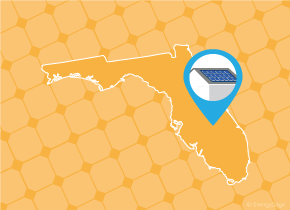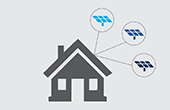History of solar policy in Florida
Although Florida is known as the Sunshine State, solar growth has only recently begun to take off in the state, as a result of low electricity prices and laws that were unfriendly to solar development. At present, Florida ranks 8th in SEIA’s national ranking with over 2,000 megawatts (MW) of solar capacity installed throughout the state. Even more noteworthy is that the SEIA projects the state to rank 2nd in solar capacity within the next five years.
One of the first notable policies that stimulated the residential solar industry in Florida is the state’s Solar and CHP Sales Tax Exemption. After taking effect in 1997, Floridians became exempt from the state’s sales and use tax when purchasing solar energy systems. Although originally set to expire in 2002, the financial incentive was extended three more years and, eventually, made permanent in 2005. The 6 percent savings Floridians receive from this exemption can make a big difference on the upfront cost of installing solar panels.
Florida’s most notable regulatory policy for its residents has been its net metering program. Despite being introduced later than net metering policies in other states, when Florida’s net metering program was enacted by the state’s Public Service Commission (PSC) in 2008 it marked a turning point for renewable energy for Floridians. For any customers of investor-owned utilities with their own solar systems, it became much easier to cut prices on their electricity bills: any surplus energy or net excess generation (NEG) produced by a solar system is carried forward as a credit at the full retail rate to the solar owner’s next bill. Eventually, at the end of a 12-month billing period, the utility pays the solar owner for any remaining NEG at the utility’s avoided cost rate.
The last major solar policy permanently enacted by Florida is its Property Tax Exclusion for Residential Renewable Energy Property. Passed in 2013, this law provides a 100 percent tax exemption for residential renewable energy properties as well as 80 percent property tax abatement for non-residential renewable energy properties.
Outside of these solar specific policies, Florida historically has trailed other states in setting and increasing Renewable Portfolio Standard (RPS). Most states successfully contributed to the growth of the renewable energy industry with RPS policies; however, Florida remains one of the few states to not have any such policy.
While Florida’s solar policy history has not always trended in the right direction, residents can still be optimistic for more clean energy on the horizon. Much of the state’s total solar capacity was built in just the past three years and meets only 1 percent of the state’s electricity needs, meaning there is plenty of room for growth in Florida. And with strong commitments to build solar from Florida Power and Light, one of the main utilities in-state, the solar industry in Florida appears set for major growth in the coming years.
















